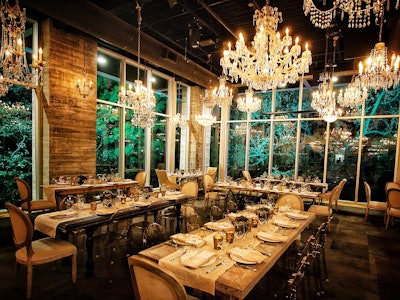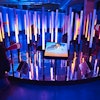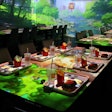
Small, seated dinners have long been a popular way for companies and brands to thank their employees or entertain V.I.P. clients in an intimate setting. But as any event planner knows, hosting an effective dinner takes much more than just gathering guests for a great meal.
While social dinner parties might be focused on reconnecting with friends, corporate dinners are usually a bit more strategic—the company wants to convey some sort of message to key stakeholders. As such, ease of communication is crucial, and that goal should bleed into everything from the decor and the catering to the seating chart and the timing of toasts.
“Corporate events [need to] think ahead to a sound system, a scripted message, and who is sitting next to whom to promote a positive networking environment,” explains David Merrell, the C.E.O. and creative director of AOO Events in Los Angeles. “There needs to be a certain return on investment for the money the company is spending [on this dinner].”
But that doesn’t mean the dinner needs to be all business, adds Christopher Confero, the owner of Atlanta-based design firm Confero. “Just because it may be in a setting with fellow professionals, don't forget to soften the space. Dim the lights, add beautiful decor pieces—anything that communicates to the guests they are appreciated and highly valued as employees and colleagues.”
Here are some more tips for creating effective dinners for corporate groups.
Design everything with the goal of facilitating conversations.
For seated dinners, centerpieces should either be below or above the sight line, so guests can talk throughout the meal. “If you place your elbow on the table and sit your chin on the palm of your hand, low decor should always be below that height,” says Confero. “If you raise your arm all the way up, tall decor should be above palm level there as well.”
It’s also important to avoid super-wide tables. “You want to be able to speak with the person across from you in a natural tone,” notes Jennifer Coman, the director of marketing and events for Los Angeles catering firm Haute Chefs L.A. “Comfortable chairs are also key, and something with a cushion is always appreciated.”
Entertainment-wise, it’s nice to have ambient noise in the background to cut down on awkward silences. Confero suggests live jazz music, or light music piped in through an audio system.
But if the event’s host wants more extensive entertainment, such as a performance of some sort, make sure it’s chosen with purpose. “If you are going to grab their attention away [from conversations], that distraction should be tying them back to the message, brand, or purpose of the event,” says Merrell.
Lighting is also an important consideration. “It is one of those things that when done well, it transforms the environment,” says Coman. “With corporate dinners, you need lighting that is not so dim that it feels like a club, but you don't want it so bright that it feels medicinal.”
Confero suggests using a lot of candles on the table. “The more the better, with varying heights and varieties,” he explains. “Typically candles will be a bit cheaper than other centerpieces, and everyone looks ravishing in candlelight.”
 A live jazz duo or other light background music can cut down on awkward silences, like at this AOO Events-designed dinner in Palm Springs, California.Photo: Rand Larson
A live jazz duo or other light background music can cut down on awkward silences, like at this AOO Events-designed dinner in Palm Springs, California.Photo: Rand Larson
Prep the event’s host on ways to keep the conversation flowing.
The dinner’s host should be responsible for keeping guests engaged and comfortable. One way to do that is with planned conversation topics. “With social or corporate dinners, many times guests aren’t familiar with the person sitting next to them,” says Merrell. “Lead questions from the host can break the silence, so always have some in your back pocket.”
Confero notes that this method also works if the party has multiple tables. One person seated at each table should be prepared with talking points. “Always put one large personality at each table,” he suggests. “If there is a lull in energy, they can jump in to pick things up. But be aware that you haven’t cast a bulldozer in this role—you don’t want someone dominating, only facilitating.”
One out-of-the-box way to facilitate conversation with a smaller group is the Jeffersonian Dinner method, where the entire table discusses one topic rather than having their own conversations with their seatmates. (BizBash covered this topic in a GatherGeeks podcast with Convers(ate) founders Taylor Buonocore Guthrie and Mollie Kinsman Khine.)
Toasts are also a great way for the host to thank everyone for coming and remind guests of the events’ purpose. “Make sure you have a sound system, or that the person giving the toast is loud enough for everyone to hear,” notes Merrell. “I also always encourage guests to not just toast with alcohol, wine, or champagne, but any drink that the guest has—you don’t want to promote drinking if [not all attendees] drink.”
As for timing, Coman says that toasts and other speeches should never be planned right before or during dessert. “We've seen it done, and you lose the crowd,” she says. “The best time for any 'talking' is going to be right when guests are getting warmed up and freshly seated, and between the first and second course.”
Think through the seating arrangements.
While assigned seating may be a good idea for dinner parties in general, it can be especially crucial for corporate dinners, says Merrell. “Meaningful business conversations and networking is one of the most important outcomes of the event,” he notes. “Seating configurations, the makeup of the guests attending, and the purpose of the gathering always dictate who is close to whom, and should always be considered separately from one event to the next.”
Confero adds that the client or host company should be involved in this process, since they know how best to group guests.
For dinners with multiple tables, it might make sense to play what Confero calls “a simple game of musical chairs.” “Each of your three courses is spent at a different table with various guests,” he explains. “It takes a bit more work for whoever is creating the seating arrangements—and of course on the kitchen and servers—but if you don’t have a large number of dietary restrictions it’s highly worth it to spend as much time as possible with different guests.”
Ask for dietary restrictions in advance—and keep catering simple.
In a corporate environment, it is especially important that guests with dietary restrictions don’t feel uncomfortable in front of their peers. “It is almost a given nowadays that you ask for restrictions such as allergies, gluten-free, or vegan,” says Merrell. “Asking up front sends the message that you care about the guests’ experience.”
With some exceptions depending on the group demographics, corporate dinners are usually not the time to get too experimental with catering. “Corporate dinners tend to stick more comfortably in the fish, chicken, and beef categories, and rarely venture beyond that,” says Merrell. Coman agrees. “Seated corporate dinners call for a plated, coursed meal with an option for restrictive diets and an easy switch-up for anyone with a serious allergy, for example. With our corporate clients, they always have a list of any executives that have allergies or dietary restrictions. In the rare case they do not [have a list], we work with our client to design a menu that is amenable to on-the-spot changes without sacrificing flavor," she explains.
Like every other aspect of the dinner, though, food should never take away from the conversations. “You'd never want to be left 'holding a skewer' or having appetizers that take more than one easy bite in a corporate setting,” notes Coman. “It can cause for an awkward moment when needing to have a professional conversation.”
Confero agrees, adding that serving soup and pasta are not always the best idea. “There are always exceptions, but they are usually messy and loud,” he notes.
But, he adds, the dessert course may be a chance to get a bit more creative. “After a large meal, get guests up and moving around,” Confero suggests. “Make the dessert course something more relaxed and interactive. With space permitting, instead of serving the final course at the table, make it a couple stations scattered around the room.”



















